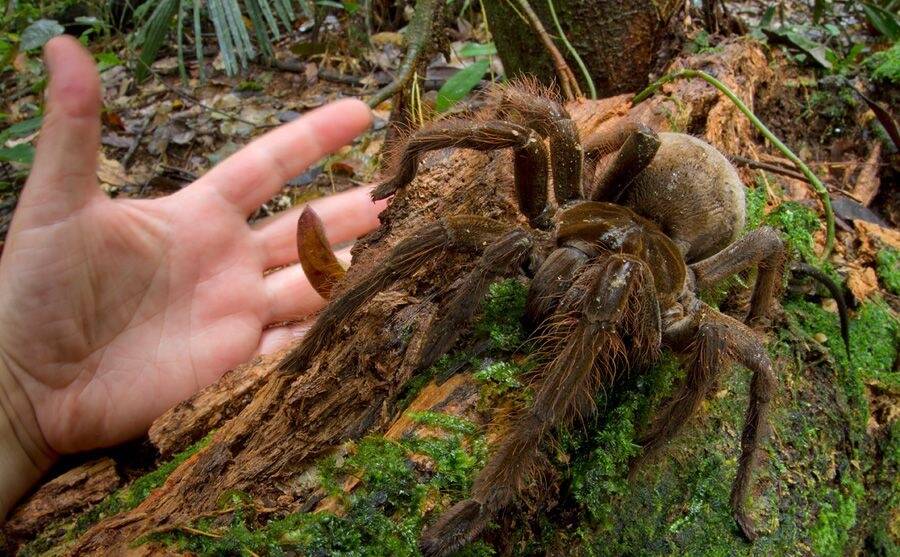
Meet The Goliath Birdeater, The Biggest Spider In The World By Weight
Human encounters with the Goliath birdeater are rarely lethal. Although their venom is dangerous enough to kill their prey, it is relatively nontoxic to humans. A Goliath birdeater bite would likely only cause some discomfort and swelling.
A bite from the Goliath bird-eating tarantula can become deadly, however, if the person bitten has an allergic reaction to the venom or if the puncture wound becomes infected.
By now, it seems that the Goliath birdeater’s notoriety has more to do with their size rather than the actual danger they pose. Their unique appearance has made them a hot commodity in the world of exotic pets, but that popularity might be a double-edged sword.
Goliath birdeaters are listed as Not Evaluated by the International Union for Conservation of Nature or IUCN, the body which monitors the status of the planet’s wildlife. Because of this, the current situation of their species is unknown. But their status as quirky pets and the low-level harm they pose to humans could have an effect on their population.
The Wellington Zoo in New Zealand is among the few places known to breed these Goliath spiders in captivity. In May 2020, zoo officials announced the successful hatching of 13 Goliath bird-eating spiderlings at their facility.
It was the first time the zoo successfully hatched a clutch of baby Goliath birdeaters in 20 years and the first time the spiders have ever been bred in Australasia.
“We’re excited to announce that we have successfully bred Goliath bird-eating tarantulas…They are an absolutely fantastic species that we’re really proud to be working with,” said Dave Laux, the zoo’s team leader of reptiles and invertebrates of the event. He added that the spiderlings were “really, really big” and their coloring was a “beautiful mahogany brown.”
Goliath birdeaters are usually solitary creatures and only seek out other spiders when it comes time to mate. Female Goliaths use their urticating hairs to cover their tennis ball-size egg sacs which typically hold between 50 and 200 eggs.
In the wild, hatchlings stay close to their mother until they fully mature at two to three years. Meanhile, the father will usually die a few months after mating.
In captivity, the lifespan of bird spiders can be anywhere between 10 to 15 years, though females have known to live up to 20 years.
A bite from the Goliath bird-eating tarantula can become deadly, however, if the person bitten has an allergic reaction to the venom or if the puncture wound becomes infected.
By now, it seems that the Goliath birdeater’s notoriety has more to do with their size rather than the actual danger they pose. Their unique appearance has made them a hot commodity in the world of exotic pets, but that popularity might be a double-edged sword.
Goliath birdeaters are listed as Not Evaluated by the International Union for Conservation of Nature or IUCN, the body which monitors the status of the planet’s wildlife. Because of this, the current situation of their species is unknown. But their status as quirky pets and the low-level harm they pose to humans could have an effect on their population.
The Wellington Zoo in New Zealand is among the few places known to breed these Goliath spiders in captivity. In May 2020, zoo officials announced the successful hatching of 13 Goliath bird-eating spiderlings at their facility.
It was the first time the zoo successfully hatched a clutch of baby Goliath birdeaters in 20 years and the first time the spiders have ever been bred in Australasia.
“We’re excited to announce that we have successfully bred Goliath bird-eating tarantulas…They are an absolutely fantastic species that we’re really proud to be working with,” said Dave Laux, the zoo’s team leader of reptiles and invertebrates of the event. He added that the spiderlings were “really, really big” and their coloring was a “beautiful mahogany brown.”
Goliath birdeaters are usually solitary creatures and only seek out other spiders when it comes time to mate. Female Goliaths use their urticating hairs to cover their tennis ball-size egg sacs which typically hold between 50 and 200 eggs.
In the wild, hatchlings stay close to their mother until they fully mature at two to three years. Meanhile, the father will usually die a few months after mating.
In captivity, the lifespan of bird spiders can be anywhere between 10 to 15 years, though females have known to live up to 20 years.
Advertisements
05 March 2024
Advertisements



